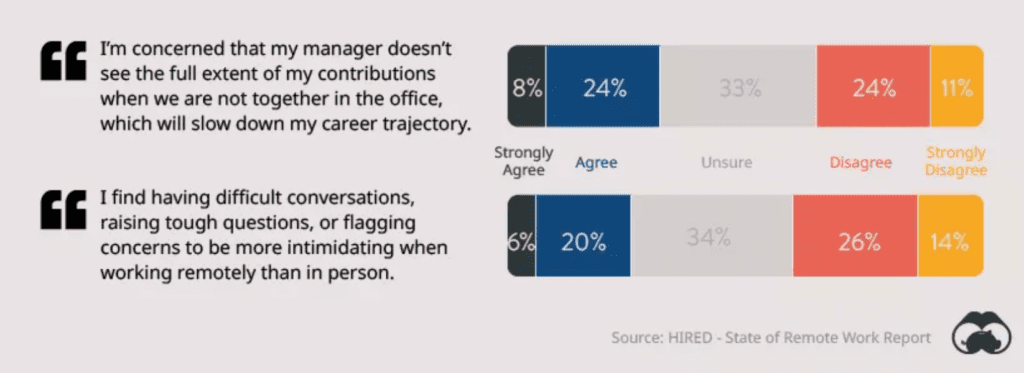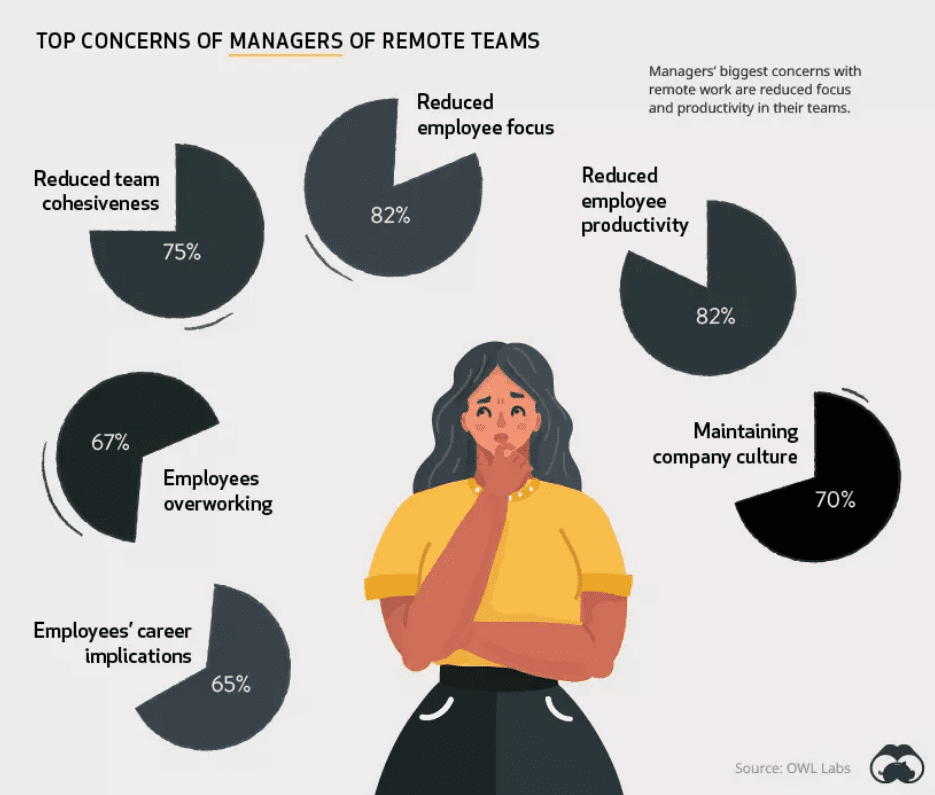Ten years ago, or maybe even five-years ago, many would not imagine that greater workplace flexibility would result in increased performance, productivity, and even higher employee retention rates. Yet, this is the story of remote work. In fact, 83% of workers agree that they don’t have to be in the office to be productive.
That’s backed up by two-thirds of employers who confirmed that their remote workers actually showed increased productivity. With that in mind, we’ll cover the basics of virtual leadership, the challenges of managing remote employees, and some skills and tools to help you own your virtual leadership journey.
In this guide
The 411 on virtual leadership
On paper, virtual leadership is a form of leadership in which teams are managed through remote working conditions. Like traditional leadership, leaders take on the role aiming to inspire and help their team accomplish their goals. In reality though, the significant difference between this form of leadership versus the traditional one lies in the approach applied.
Upping your game as a virtual leader
Virtual leadership is a different ball game so if you want to take this up a notch, here’s the catch: you’ll need to adjust your leadership style and explore different approaches to reach your full potential as a virtual leader. This means knowing how to utilize different tools and even adjust certain skills and your mindset, as this is a completely different field from what you’re used to!
Virtual leadership heavily focuses on amplifying collaboration and morale through open communication, absolute transparency, and ingrained accountability. So to get you started, here are a few tips for managing remote teams. Keep these in mind to become an effective virtual leader:
- Great writing skills that enable you to translate empathy and understanding into a written virtual context that is easily comprehensible.
- Transparency regarding your company goals and your desired outcomes. This will make your team members more engaged and help them take accountability for the work they’re doing.
- The tools that maintain an open line of communication and share status updates with other members on a routinely basis.
- Avoid micromanaging your members and give them the independence to work and be accountable for their actions and the results of their labor.
Anticipate virtual leadership challenges
With this new leadership style and work setting, you will have to cross bridges you haven’t encountered before. You and your team members may find it difficult to adjust to this new work setting at first. But implementing good time management and setting up a new inter-team structure can eventually help your team get past the adjustment period (you can read more here to help you adjust to working from home!). Actually, 43% of remote workers reported that they love weekly one-on-one check-ins with their managers as it helps them to stay connected and up-to-date.
Different virtual communication styles
s cliché as it might sound, communication is the key to maintaining a good relationship, especially in a remote workplace.
When creating a structure for your virtual team, it is crucial that you set up communication channels for your team such as an avenue where they can respond passively (through emails) as well as actively (such as by instant messaging). Ensure that your team is flexible through both avenues to settle potential communication differences. Additionally, you need to set business hours which is a common time where everyone can be online. It doesn’t matter where they are — as long as they’re online during these business hours, then you will be able to communicate, brainstorm, and collaborate with them on specific tasks and projects.
Structure - or lack there of
Communication is one thing, but structure is another key component that will either make or break your virtual team’s collaboration.
Structure is important for virtual teams because, without it, your collaboration might break down. The best solution to this problem is creating a workflow analysis and strategizing how you work together as well as what processes need more attention than others in order to meet deadlines. Having set goals will help motivate team members by providing a clear direction on where their responsibilities lie in relation to achieving those objectives, while supervision can be used to ensure all allocated tasks get completed efficiently with no wasted time or effort!
A lacking tech-stack
There are gaps that you simply cannot turn a blind eye to, especially when you’re transitioning from physical to virtual leadership. And since you’re working remotely, having access to the best tools for managing remote teams can help to fill in those gaps. Some of our favorite virtual collaboration tools are:
Notion is a powerful new app that can help you maintain your sanity when it comes to keeping on top of all the tasks and projects on your plate. It does this by helping you keep track of deadlines, meetings, and notes like never before with its sleek interface that allows you to create and customize pages, task lists, meeting notes, and so much more.
Think of Trello or Jira as your team’s virtual corkboard. With Trello, you can keep track of all your projects and ideas. It can be extremely useful for checklists as you can create different boards for each project team, organize tasks with labels and color-coded cards, and manage your overall to-do list. Jira, on the otherhand, is a must for most technical teams.
A quick question: if you could catch up on your meetings in minutes, would you still attend live?
This the problem we’ve solved with our meeting recording infrastructure. Automatically record, share and timestamp your meetings. Connect your meetings with your existing tech-stack too!
Slack offers real-time messaging and archiving for teams. In addition to messaging, it has a robust set of tools that includes tagging, search, and powerful integrations with other services like Notion.
This one if our favourite video conferencing platform/tool as it is really simple and widely used. This means, no fuss regarding set-up or maintaining a consistency across internal and external meetings.
Trust
Trust is probably worth it’s own blog – probably even a thesis. But, we’ll try and summarize some key points in our opinion.
Trust, as we all know, can be eroded (or never gained) for a number of reasons for both office-bound and virtual teams. However, let’s focus on building and maintaining it. Some common practises to doing so include: transparency and open documentation That way, everyone can be noted with each other’s progress and task allotment per week, lessening that pesky “this task was passed over to me” conundrum.
Other key elements include empathy, reliability, and active listening. Regardless of where you lead (online or offline), if your team feels unheard or misunderstood, trust will take a hit.
Distractions
You may not admit it, but it’s easy to get distracted. Whether working at home or elsewhere, distractions are oftentimes unavoidable. But you’ll be surprised to know that remote workers find their home office to be more conducive for work as compared to an office setting. And that’s mainly because there are no 30-minute “small talks” with co-workers and 7% less time talking to upper management.
The best management procedure to limit distractions even remotely is by setting up guidelines and standards, specific for the team. Assess your team’s home workspace environment and identify areas on how to eliminate these detractors. By making sure they have all the work devices and equipment they need to perform, you’ll be able to eliminate some of these detractors and they will also have no excuse for underperforming — just because they’re working at home. Yes, they should feel comfortable but you also need to make them accountable so see to it that your work expectations are clear.
Async vs sync
In a remote work setting, we celebrate flexibility and we focus on results and productivity so instead of requiring everyone to keep their eyes peeled for messages, be clear when certain tasks or messages are more urgent than others. If there’s no room for ambiguity and when communication lines are open, you can focus on fostering effective and productive asynchronous communication channels.
Team bonding
Sometimes working remotely treads the vague line of personal and professional time. While this can be a challenge to some, it can also be an asset. It’s important to create a work culture, but dancing between the lines can get you in a relaxed and inviting position with your members and others, which can help build stronger relationships.
Find some time once in a while to squeeze in some game nights, host remote pizza parties or create a fun meeting routine. For instance, during your regular weekly or monthly meetings, you can start with an icebreaker first before moving to the meeting proper.
The only virtual leadership toolkit you'll ever need is right here!
This is a collection of some of our favourite reads, podcasts and other ranges of educational (and inspirational) material for leadership cultivation. Is there anything you’d add to this list? Email [email protected].
Tools and apps 🛠️
Some of our favorite tools to aid remote work were listed above. We’ve reiterated these below and added in a few extra favorites. These are tools and apps either designed to help remote life or virtual leadership.
Notion is a powerful new app that can help you maintain your sanity when it comes to keeping on top of all the tasks and projects on your plate. It does this by helping you keep track of deadlines, meetings, and notes like never before with its sleek interface that allows you to create and customize pages, task lists, meeting notes, and so much more.
Check out our Notion meeting templates here.
Think of Trello or Jira as your team’s virtual corkboard. With Trello, you can keep track of all your projects and ideas. It can be extremely useful for checklists as you can create different boards for each project team, organize tasks with labels and color-coded cards, and manage your overall to-do list. Jira, on the otherhand, is a must for most technical teams.
A quick question: if you could catch up on your meetings in minutes, would you still attend live?
This the problem we’ve solved with our meeting recording infrastructure. Automatically record, share and timestamp your meetings. Connect your meetings with your existing tech-stack too!
Slack offers real-time messaging and archiving for teams. In addition to messaging, it has a robust set of tools that includes tagging, search, and powerful integrations with other services like Notion.
One of the great hidden gems that Slack has is that of an RSS reader! This cool, unique feature enables you to be notified with the latest news articles, podcasts and content as they’re published. It can be shared in a channel, or even for your eyes only. Simply just paste or type down the RSS feed you want to subscribe to and add “/feed subscribe” after your RSS feed URL. And another reason we love this tool is because of its variety of bots! These fun and innovative bots like TaskOnBot, Donut, Fortay, and BirthdayBot allow you to automate various tasks at work as well as improve company culture and productivity.
This one if our favourite video conferencing platform/tool as it is really simple and widely used. This means, no fuss regarding set-up or maintaining a consistency across internal and external meetings.
Aside from the fast that they were recently funded $400 million in series C, ClickUp is an excellent project management board. It is a cloud-based platform that allows you to organize projects with notifications, calendars, and goals. It also allows task managers to customize stages of development for a streamlined workflow.
Google Vault acts as an archiving tool that can help you easily look up sensitive information from a long time ago. It has this sophisticated searching capability that allows users to search by file type, date, keyword and user. If you’re not much into archiving, no worries, Vault can also act as an auditing tool. It can generate copies under a specific category to help you come up with quick and reliable audit reports.
Work Insights provides you with a clear oversight of how much your team members are engaging through stats. It’s like Google Analytics but for your team members, allowing you to get information on their level of productivity, collaboration and adoption.
Mindmeister is a breath of sigh for virtual team leaders when it comes to easy access and convenient brainstorming. This cool, unique tool enables you to collaborate, share, visualize and even present ideas in a jiffy. It has an integrated chat, which is cool so that your team can easily vote on topics and comment on ideas. It’s your greatest tool that can substitute for whiteboards, chart papers and visualizers in a physical brainstorming setting!
Lastpass will be your new best friend when you are having a hard time tracking passwords for your team members. This cool password manager tool enables you to condense all your passwords in a nifty and safe space where your teammates can access it anytime needed! Just pop in your passwords and let go of your worries about getting bothered tracking a login again.
Podcasts 🎙️
There are A LOT of awesome podcasts out there in the remote community. We’re spoilt for choice, but here’s a few of our favourites!
The Remote Show – We Work Remotely’s The Remote Show podcast explores every aspect of remote work life. This podcast will keep you up-to-date on remote working, from the tools used by remote workers to how remote teams manage their productivity.
Collaboration Superpowers – Every week, remote work experts gather on this podcast to discuss remote work, tools of the trade, and how to succeed as a remote worker or remote-first organization.
Virtual Frontier – The Virtual Frontier is an excellent podcast produced by Flash Hub that provides advice on managing virtual teams. There are topics discussed such as managing virtual teams in an emergency, flexible work, and team culture.
Management Cafe – Management Cafe is the podcast for anyone managing remote teams. Host Pilar Ortis covers topics like emotional intelligence, coaching and communications to make your life as a manager easier!
Here’s a taste of the Remote Show, hosted by Tyler Sellhorn. He frequently has many heavy hitters in the remote world on his show!
Some inspiring reads 📚
Here are a few helpful articles to read about remote work and if you want some more inspiration when working from home! We’re still adding our favorites to this list…
Virtual leadership training 🧠
Working remotely is a great way to work, but it takes time to learn these skills. However, once you’ve mastered these you’ll be able to work more effectively. One important benefit it that there now should be no limit to where you hire your next team member, as timezone or geography is no longer a barrier, with these newly acquired skills.
So if you want to learn more about how to succeed in the virtual-work landscape, have a look at these amazing courses:
Everything else...
You can check out this really cool (and helpful!) RSS feed to help you maximize your virtual leadership – Maximizing Virtual Leadership Learning (SmikleSpeaks by Joanne L. Smikle, PhD). We’ve also got some of our favourite Twitter threads below!
Below is a thread about the future of remote work after the COVID-19 pandemic is over. I predict that remote will go through a trough of sorrow due to hybrid not working out, and most companies will return to being office based. But many all remote companies will see success.
— Sid Sijbrandij (@sytses) May 23, 2020
1/ I've been managing people remotely for 8 years. Here's how to be a better manager in a remote (distributed) team:
— Job (@Jobvo) March 25, 2021
Let's wrap it up!
85% of managers believe that remote working will become a standard practice for many companies in the future. And as a leader, you want the very best for your team. It’s a well-known truth that keeping your employees happy will produce great results, but remote teams, while they’re well-received by many employees and companies alike, also have their own set of challenges. And as a remote manager, it is your duty to keep everyone motivated, driven, and productive. So follow these tips and tricks from and your team will be a juggernaut in the virtual workspace in no time! Happy leading!







